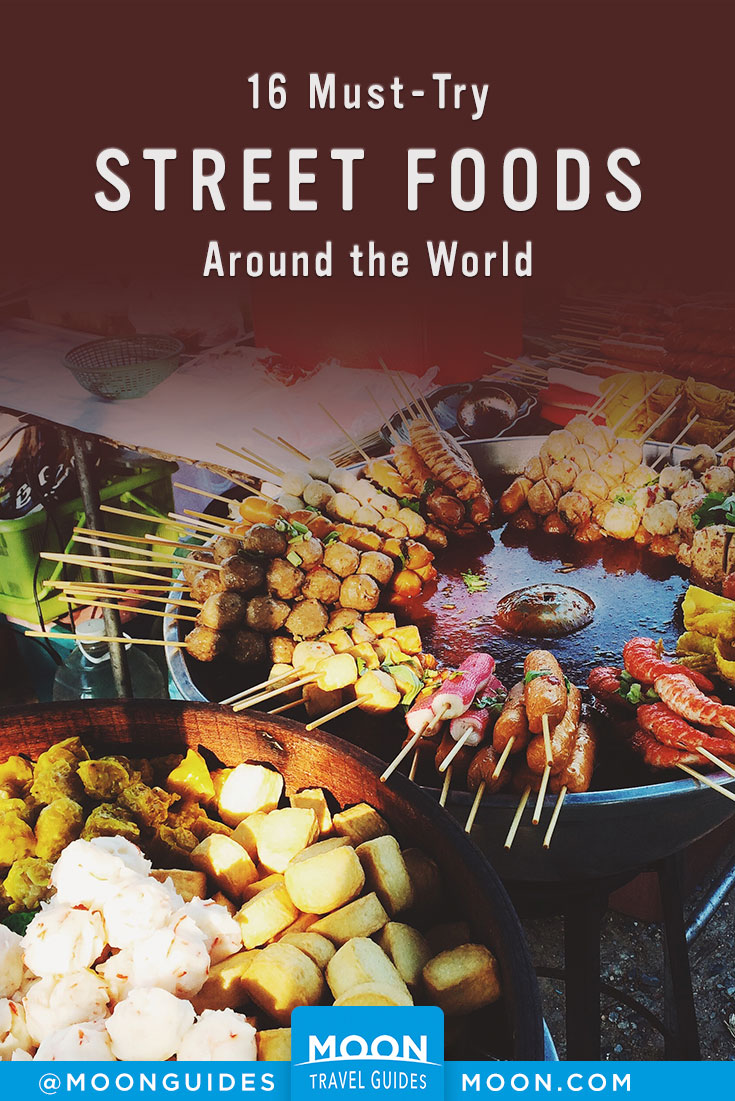16 Street Foods to Try Around the World
Eating on the street is often one of the great pleasures of travel. In many countries, it is even the dominant dining style. A ton of options, good food on the run, and (often) cheap prices—what’s not to love? Whether it’s a cone of fries in Brussels, a pizza in Naples, a hot dog in New York, pad thai in Bangkok, a kebab in Istanbul, or a tortilla in Mexico City, there are unique pleasures to be found everywhere you go. Here is a little tour of the world of street food. Enjoy!
Thailand
The Kingdom of Street Food
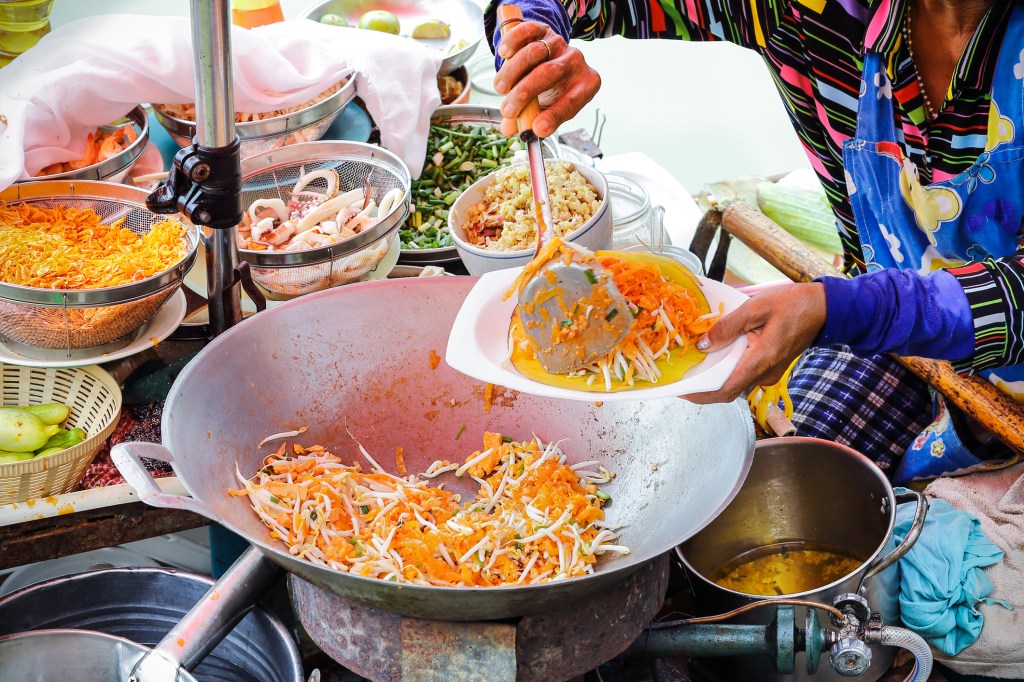
Many travelers are of the opinion that Thailand has the best street food in the world. It’s certainly true that there’s a huge range of options available anytime, day or night, especially in Bangkok. Just about everywhere you look, you see cooks and vendors working at a simple folding table, a trolley, a tricycle, a boat—and that’s when you don’t come across one of them carrying baskets hung across their shoulders.
There is an enormous variety of dishes and they are generally well spiced: kaho man kai (chicken rice), pad thai (stir-fried rice noodles with egg and often shrimp), pla krapong tot nam pla (fried fish fillet with fish sauce), phad kaprao (chicken, egg, basil, oyster sauce), som tam (papaya salad), and on and on. For those who want a little culinary adventure, there is also taka-taen, fried grasshoppers.
Vietnam
The Sacred Pho
As in Thailand, you have plenty of choices among the gastronomic specialties sold by a multitude of street merchants, whose stalls often move around. The most common is probably pho, a beef soup flavored with fresh herbs and onions. But other mouthwatering choices include bun bo (noodle soup with beef, pork, vegetables, lemongrass), rau muong (water spinach fried with garlic), or an array of rice dishes with all kinds of ingredients. Vietnamese sandwiches are also well worth a try: the banh mi consists of a French baguette usually filled with pork, raw vegetables, herbs, and hot sauce, but there are a lot of variations out there. Banh bao are rolls filled with pork, eggs, and vegetables. The banh khoai is a crepe loaded with greens and topped with pork, shrimp, and bean sprouts.
China and Taiwan
The Empire of Xiaochi
Xiaochi are the “little bites” offered to you in the streets and markets of mainland China and Taiwan—especially at night—with each vendor offering their own unique fare. Under this generic term, there are a multitude of dishes that can be more elaborate than the haute cuisine served in fancy restaurants. You could spend your whole life here and never taste them all! Among the xiaochi dishes you will find are soups, rice, noodles, dumplings (including the famous jiaozi), stuffed buns and pancakes, and pastries. In Taiwan, you’ll find xiaochi that mix Chinese recipes with culinary influences from the West, the Middle East, or Japan. Note that, on holidays, there are special xiaochi that you can only enjoy on these occasions.
Japan
Where You Always Come Back to the Ramen
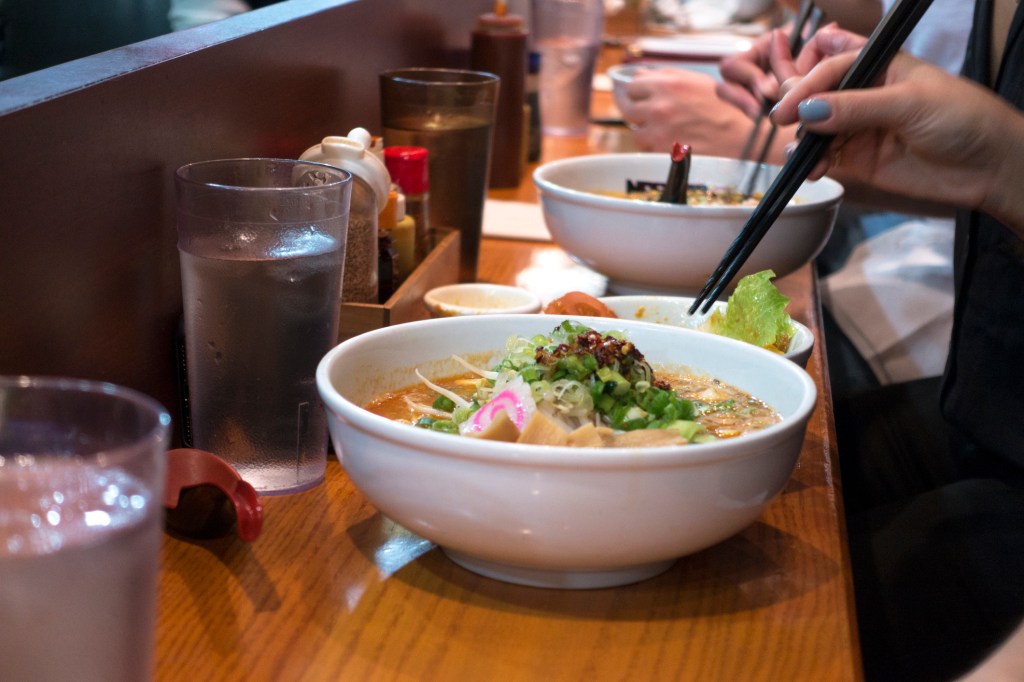
Ramen is practically worshiped in Japan. Of Chinese origin, this dish consists of noodles in a broth of meat or fish, often mixed with a soy sauce or miso. Made from wheat flour with added yeast and kansui—a mixture used for making dough and which gives the broth a yellow color—the noodles can be straight or wavy, and of varying their lengths and thicknesses. The toppings are numerous. For example, pork, eggs, black mushrooms, pickled bamboo, dried seaweed, naruto fish cakes, cabbage, and many more ingredients may be used. You can find ramen in stalls on the street and in restaurants—and of course in convenience stores and supermarkets in instant “Cup Noodle” form.
India
Tasty Chaats
Chaat is everywhere in India, as in Pakistan. The most traditional variety of this snack involves pieces of potato (aloo) and unleavened bread (puri) or a preparation made with chickpeas (besan). The garnishes of these very tasty dishes (samosa, pakora, katchori) are fried in front of you in the street or in train stations. They are generally spicy (coriander, pepper, cumin, ginger, pepper) and have yogurt and various vegetables (tomato, onion). There are endless varieties, especially in the north of India, where chaats originate. Each city or region has its own recipes.
Israel
Falafel and Sabikh, Sandwiches of the Middle East
In Israel, you will quickly notice that street food is as much Western as it is Middle Eastern. Throughout the Middle East, you can find pizzas and burgers as well as popular sandwiches like falafels, which are made with balls of ground chickpeas fried in oil. These are served in a pita or another such bread with yogurt, tahini (a sesame paste or sauce), or hummus (mashed chickpeas with tahini and olive oil) and topped with raw vegetables. Pita is also the vehicle for sabikh, a sandwich of Iraqi origin. It is filled with many simple things—hardboiled egg, fried eggplant, potato, tomato, cucumber, hummus, and parsley—and seasoned with amba, which includes mango and vinegar, mustard and spices.
Turkey
The Cradle of Kebab
Döner kebab is one of the inventions of Ottoman street gastronomy that has conquered the world, but you have to go to Turkey to get the real thing. Essentially, these kebabs are slices of meat (mutton, veal, chicken) that are marinated in a mixture of spices, olive oil, and milk, then mounted on a vertical rotisserie. After being roasted, the meat is cut into thin slices, which are served on a stiff bread, pita or dürüm. There are lots of potential accompaniments: lettuce, tomato, pepper, onion, yogurt, sauce, spices…Turkish street vendors also offer a plethora of other snacks: balik ekmek (grilled or fried mackerel sandwich with lettuce, onion, tomato, lemon juice); kokorec (sandwich with a kind of spicy lamb sausage); kumpir (big baked potato with butter and sheep cheese, plus various ingredients such as corn, olives, peas, mushrooms); lahmacun (a kind of pizza with lamb, tomato, chopped onion, and pepper); midye tava (fried mussels); and pogaca (bread flavored with olive oil that can include cheese, minced meat, and potato), just to name a few.
Lebanon
Meaty Shawarma, Kibbeh, and Kefta
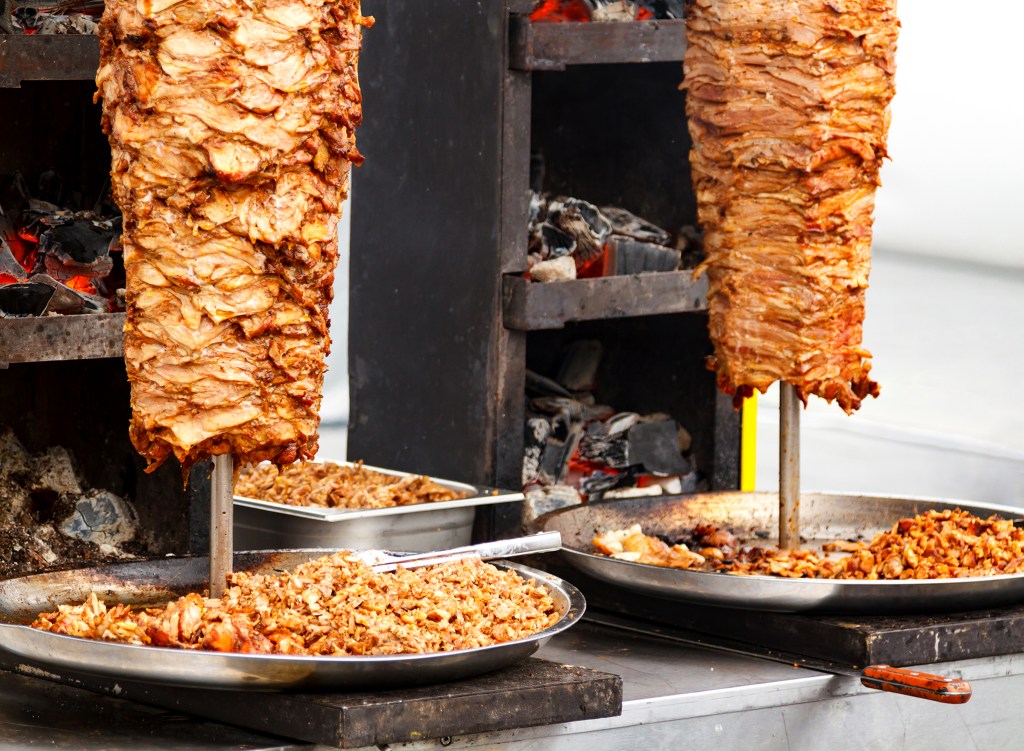
The delicious foods of Lebanon are easy to enjoy in the street. Shawarma is one of the most beloved. Often served in a sandwich, shawarma belongs to the kebab family and consists of meat (beef, lamb, or chicken) cut into thin slices and stuffed into a pita or a dürüm pancake with vegetables and sauce. Also popular is kibbeh, a fried croquette containing lamb, or sometimes goat or beef, minced very thin and mixed with crushed wheat (bulgur), onion, mint, and various spices. Kefta is a meatball of minced meat, lamb or beef, with onion and spices cooked on skewers, which is served in a pita. Note that kibbeh and kefta are also traditionally part of the small plates served in a large meal.
Morocco
The Braseors of Jemaa El-Fnaa in Marrakech
There are dozens of street-food specialties to be found on the famous Jemaa el-Fnaa square of Marrakech. Treasures of Moroccan cuisine, both great and small, can be tasted at the various stands, but they are only open in the evening on this vast esplanade. You can buy something to eat during your strolls through the city or sit at one of the precarious tables set up on the road, under an awning that barely protects you from the fumes rising from braziers. This market is divided into specialized sections; it’s up to you to wander around to compose a complete menu, but options abound—grilled meats (pork, mousses, merguez), fish, snails, seafood, salads, couscous, mechoui, and mutton—not to mention desserts and teas, also prepared in Moroccan style.
Get the ultimate travel inspo book:
Quebec
Poutine and Bagels
Poutine, a Quebecois specialty, consists of French fries topped with fresh cheese curds and gravy. What a dish! Building on that basic recipe, variations abound: eat it with sausage, ground beef, chicken, shrimp, cabbage, Bolognese sauce, or foie gras. You will find poutine both at the table and in the street, at the counter of a roulotte à patates (a food truck devoted to poutine). In Montreal, the bagel, imported by Jewish immigrants from central Europe, has become a real specialty, cut in half and filled with whatever you want. Traditionally, it is smeared with cream cheese and sliced smoked salmon. It is smaller and thinner than its renowned New York cousin.
Latin America
Empanadas Without Borders
Each South American country has its own take on empanadas. Some travelers even make a game out of keeping track of which kinds they’ve had. The basic format is a pastry made from corn or wheat flour, but its appearance, its texture, what is inside, and whether it’s baked or fried, vary depending on where you are. Common ingredients include ground meat, boiled eggs, cheese, raisins, olives, onions, tomatoes, peppers, and spices. Chicken, fish, or seafood can also be part of it.
But empanadas are not the only snacks worth beating the pavement for in the streets of Latin America. In Venezuela and Colombia, arepas are very popular. This bread made from corn flour is stuffed with chopped meat, cheese, egg, avocado, beans, and more. In Argentina, you have choripán, a chorizo sandwich with chimichurri, a condiment with various herbs and spices.
Brazil
Acarajé, Pão de Queijo, and Coxinha
Brazilian street food is different from what you’ll find in the rest of South America. In the city of Salvador de Bahia on the Atlantic coast, the great specialty is acarajé. African-inspired, it is a kind of dough ball made with bean flour and onion and deep-fried. It can be filled with vatapá (a saucy dish containing bread, coconut milk, and peanuts) or caruru (which is made from okra, shrimp, and other ingredients). Everywhere in Brazil, you can enjoy another battered and fried food called coxinha. Its dough is stuffed with chicken pan-fried with onion and garlic, though you can also get it with shrimp, beef, or catupiry cheese. Also very popular, the pão de queijo is a round loaf made with cassava flour and cheese, which are the best in the southeastern state of Minas Gerais.
England
United Kingdom of Fish & Chips
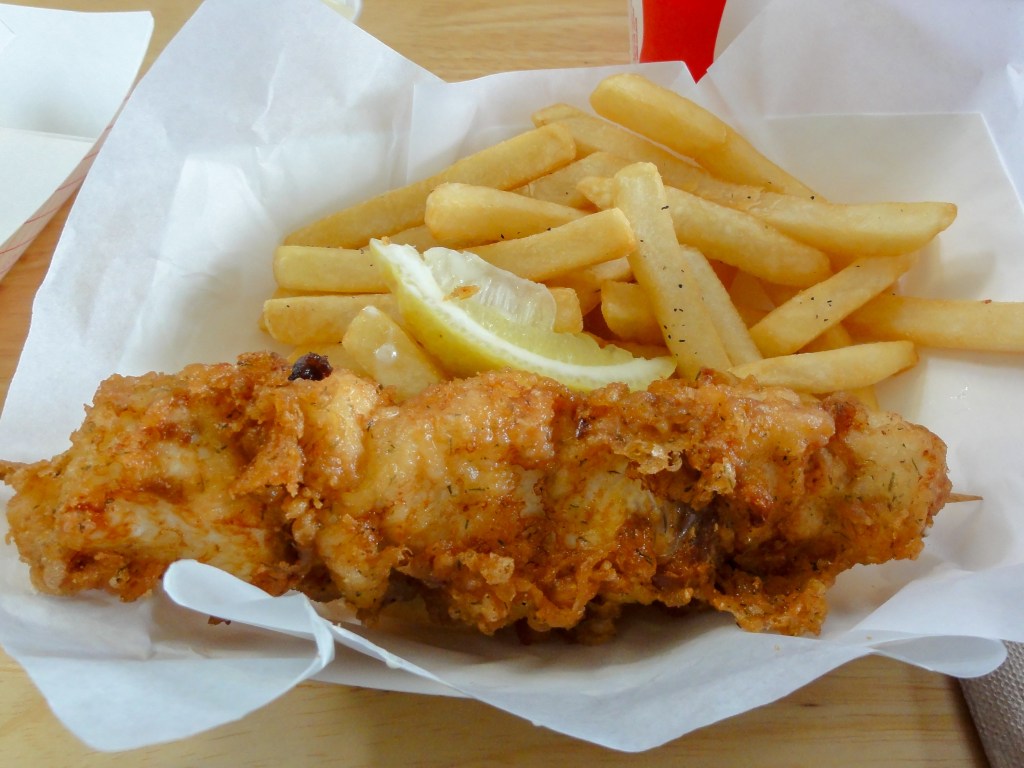
Despite competition from all kinds of street foods imported from all over the world, fish and chips remain an institution in England. The recipe is very simple: Take a white fish fillet, whole or in pieces, cover it with beer batter, and fry it in boiling oil to make the dough crisp. Then serve it with french fries and salt in enough absorbent paper to soak up the excess grease. Baked potatoes also require little skill and are one of England’s unpretentious specialties. For toppings, you will find cheese, bacon, eggs, minced meat, sour cream, onion, and more. Otherwise, note that in the big cities, the markets are full of stands that sell Indian, East Asian, Lebanese, West Indian, African, Italian, and even French snacks. God save the queen!
Italy
Not Just Pizza
Does pizza really need an introduction? In Naples you will find the most famous variety under the label “vera pizza napoletana.” Its trademark characteristics: a diameter no more than 14 inches (35 cm), a crust no higher than 1 inch (2 cm), and a sauce no thicker than 0.2 inches (0.4 cm). Fine and supple, its marinara sauce is made of tomatoes, extra virgin olive oil, garlic, and oregano; if it comes with mozzarella and fresh basil it’s a Margherita; with mozzarella di bufala campana, it is a Margherita extra.
Beyond pizza you’ll find focaccia, a flatbread drizzled with olive oil and topped as you like: tomato, olive, cheese, meat, herbs, onion, various vegetables. Born in Liguria, there are endless variations of it throughout Italy. Porchetta is also widespread but is especially popular in Rome. These succulent slices of suckling pig are rolled around spices and roasted. It can be eaten hot or cold and often shows up in a panino (the singular form of panini in Italian).
Belgium
Fried Street Food
Oh, Belgian fries! For many, they are simply the best. The chip shops are essential stops in the flat Flemish country and the Walloon valleys—as they are in the far north of France. Whether served in a cone or on a tray, good Belgian fries are generally fried in beef fat, also called blanc de bœuf. If you really, really like fries, you might enjoy the curiosity that is the Frietmuseum of Bruges.
Another specialty is caricoles, a quintessentially Belgian food: the little snails necessary for this dish are rare nowadays, but you can still find them at some street vendors. On the sweet side, Belgian waffles are, of course, a must. You have to try the kind from Brussels, the classic, which is served hot with powdered sugar or whipped cream. And then there is the round waffle of Liège, whose dough is laced with cinnamon and which is eaten cold or hot with pearl sugar.
Germany and Austria
Sausages at the Imbiss
Anyone who has wandered through the streets of Germanic cities has noticed food stalls, with tantalizing aromas beckoning in passersby. These stands are called Imbiss, and they mainly sell wurst (sausages). Wurst is available in several hundred varieties, one of the most famous being the Frankfurter, which is used in the well-loved currywurst—grilled or fried sausage that cut into pieces and drizzled with curry and tomato sauce (though unfortunately this is often replaced by ketchup). It is served on a plate or in bread, with fries—all ideally accompanied by a beer, natürlich.
And if eating in the street does not suit you, find a beer garden, a terrace surrounded by greenery with stands where you can order snacks and drinks. These are particularly popular in Munich, where they were invented.
By clicking ‘Sign Up,’ I acknowledge that I have read and agree to Hachette Book Group’s Privacy Policy and Terms of Use
Build Your Travel Bucket List
Pin it for Later
